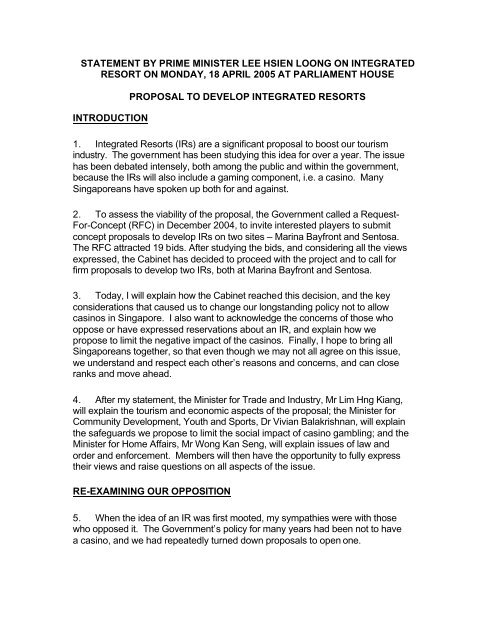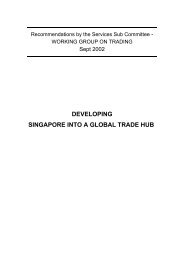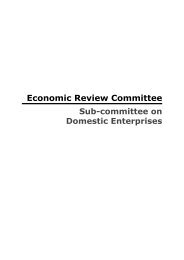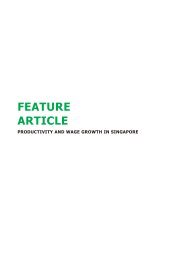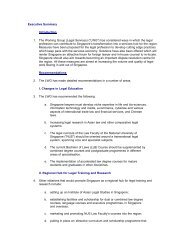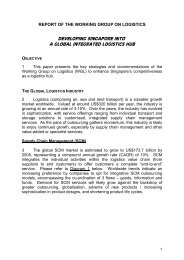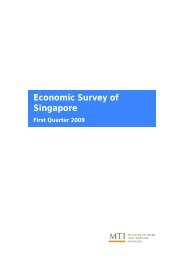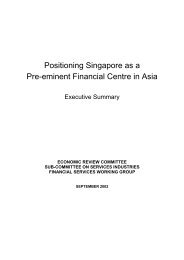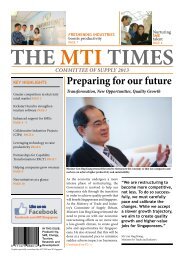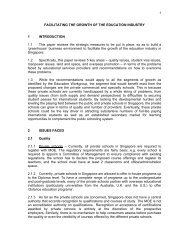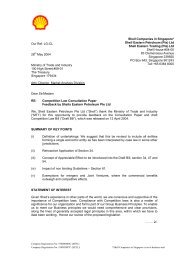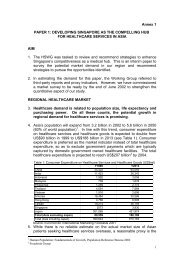statement by prime minister lee hsien loong on integrated
statement by prime minister lee hsien loong on integrated
statement by prime minister lee hsien loong on integrated
You also want an ePaper? Increase the reach of your titles
YUMPU automatically turns print PDFs into web optimized ePapers that Google loves.
STATEMENT BY PRIME MINISTER LEE HSIEN LOONG ON INTEGRATEDRESORT ON MONDAY, 18 APRIL 2005 AT PARLIAMENT HOUSEINTRODUCTIONPROPOSAL TO DEVELOP INTEGRATED RESORTS1. Integrated Resorts (IRs) are a significant proposal to boost our tourismindustry. The government has been studying this idea for over a year. The issuehas been debated intensely, both am<strong>on</strong>g the public and within the government,because the IRs will also include a gaming comp<strong>on</strong>ent, i.e. a casino. ManySingaporeans have spoken up both for and against.2. To assess the viability of the proposal, the Government called a Request-For-C<strong>on</strong>cept (RFC) in December 2004, to invite interested players to submitc<strong>on</strong>cept proposals to develop IRs <strong>on</strong> two sites – Marina Bayfr<strong>on</strong>t and Sentosa.The RFC attracted 19 bids. After studying the bids, and c<strong>on</strong>sidering all the viewsexpressed, the Cabinet has decided to proceed with the project and to call forfirm proposals to develop two IRs, both at Marina Bayfr<strong>on</strong>t and Sentosa.3. Today, I will explain how the Cabinet reached this decisi<strong>on</strong>, and the keyc<strong>on</strong>siderati<strong>on</strong>s that caused us to change our l<strong>on</strong>gstanding policy not to allowcasinos in Singapore. I also want to acknowledge the c<strong>on</strong>cerns of those whooppose or have expressed reservati<strong>on</strong>s about an IR, and explain how wepropose to limit the negative impact of the casinos. Finally, I hope to bring allSingaporeans together, so that even though we may not all agree <strong>on</strong> this issue,we understand and respect each other’s reas<strong>on</strong>s and c<strong>on</strong>cerns, and can closeranks and move ahead.4. After my <str<strong>on</strong>g>statement</str<strong>on</strong>g>, the Minister for Trade and Industry, Mr Lim Hng Kiang,will explain the tourism and ec<strong>on</strong>omic aspects of the proposal; the Minister forCommunity Development, Youth and Sports, Dr Vivian Balakrishnan, will explainthe safeguards we propose to limit the social impact of casino gambling; and theMinister for Home Affairs, Mr W<strong>on</strong>g Kan Seng, will explain issues of law andorder and enforcement. Members will then have the opportunity to fully expresstheir views and raise questi<strong>on</strong>s <strong>on</strong> all aspects of the issue.RE-EXAMINING OUR OPPOSITION5. When the idea of an IR was first mooted, my sympathies were with thosewho opposed it. The Government’s policy for many years had been not to havea casino, and we had repeatedly turned down proposals to open <strong>on</strong>e.
6. In 1985, when Singapore experienced a severe recessi<strong>on</strong>, the idea to opena casino <strong>on</strong> Sentosa came up, not for the first time. Mr Goh Chok T<strong>on</strong>g, whowas then the First Deputy Prime Minister, turned down the proposal.7. In 2002, I chaired the Ec<strong>on</strong>omic Review Committee (ERC) looking for newstrategies to grow our ec<strong>on</strong>omy. Mr Wee Ee-chao led the Tourism WorkingGroup. He wrote to me proposing a “world class gaming facility”. I replied to himexplaining why I was against it. Let me quote from my letter to Mr Wee:“There may be ec<strong>on</strong>omic merits to setting up a casino in Singapore. Butthe social impact is not negligible. By making gaming more accessible andeven glamorous, it could encourage more gambling and increase the risk ofgaming addicti<strong>on</strong>. A casino could also lead to undesirable activities likem<strong>on</strong>ey laundering, illegal m<strong>on</strong>ey lending and organised crime. Although<strong>on</strong>e can try to mitigate these effects, the l<strong>on</strong>g term impact <strong>on</strong> social moresand attitudes is more insidious and harder to prevent.”CHANGING CIRCUMSTANCES8. But the issue did not go away. MTI which is resp<strong>on</strong>sible for the ec<strong>on</strong>omywas getting worried as the competiti<strong>on</strong> envir<strong>on</strong>ment changed. Two years later, in2004, MTI put up a case for an IR. Three major developments caused us to reexamineour positi<strong>on</strong>:Tourism Trends9. First, we are losing ground in tourism. Tourism in Asia is growingphenomenally, especially the traffic from China and India. Singapore’s touristnumbers are up too, but we see warning signs of problems ahead. Our marketshare is declining (from 8% in the Asia Pacific regi<strong>on</strong> in 1998 to 6% in 2002).Tourists are spending less time in Singapore. They used to stay an average ofabout 4 days in 1991, but now they stay <strong>on</strong>ly for 3 days. In c<strong>on</strong>trast, <strong>on</strong> average,they are staying for about 4 days in H<strong>on</strong>g K<strong>on</strong>g, 5 days in L<strong>on</strong>d<strong>on</strong> and almost aweek in New York City. We are losing attractiveness as a tourist destinati<strong>on</strong>.10. Why is that so? The feedback we have been getting is that Singapore isseen as unexciting. We have not been investing in tourism infrastructure projectsthat are crowd pullers. So there are too few things to do that hold the attenti<strong>on</strong> ofthe tourists. Writers from H<strong>on</strong>g K<strong>on</strong>g and Taiwan laugh at us, saying thatSingapore is , i.e. the water is too clear, so that there are no fish. If wedo nothing about it, visitors from the PRC and India will so<strong>on</strong> feel the same.
11. This is not just a matter of chasing tourist numbers. Many jobs are at stake– in the hotel, food and beverage, retail, taxi, exhibiti<strong>on</strong>, and aviati<strong>on</strong> industries.All these depend <strong>on</strong> tourism traffic. As a Merrill Lynch report observed:“The EDB has had successes with its initiatives in the areas of biomedicalsciences, educati<strong>on</strong>, logistics and supply chain management, and financialservices. But it is… (the IR project)…that tips investor mindset towardaccepting that Singapore is transforming itself into a diversified servicebasedec<strong>on</strong>omy.”Cities Reinventing Themselves12. The sec<strong>on</strong>d major development is that cities all round the world arereinventing themselves.13. New York City has been undergoing a renewal. The current and previousmayor (Bloomberg and Giuliani) have remade the city <str<strong>on</strong>g>by</str<strong>on</strong>g> cleaning up the streets,and clamping down <strong>on</strong> crime. New York is rebuilding <strong>on</strong> the World Trade Centresite, a new and ic<strong>on</strong>ic development. They are building a New York Sports andC<strong>on</strong>venti<strong>on</strong> Centre (NYSCC), to draw in more tourists and c<strong>on</strong>venti<strong>on</strong> traffic. Theproject costs US$2.2 billi<strong>on</strong>, and the city and state are c<strong>on</strong>tributing US$600milli<strong>on</strong>. New York is also putting up spectacular activities to draw visitors, arecent <strong>on</strong>e being an eye-catching art exhibiti<strong>on</strong> in Central Park called “TheGates”– comprising 7,500 big saffr<strong>on</strong> banners meandering through the park.14. Paris is also getting a shake-up, even though it attracts 25 milli<strong>on</strong> tourists ayear, 3 times as many as Singapore. The city is redesigning its traffic flow; themayor has built a very popular artificial beach al<strong>on</strong>g the River Seine; and startednightl<strong>on</strong>g street parties. During the first party, the mayor was assaulted andstabbed. But as he was carried away <strong>on</strong> a stretcher, he told the crowd to carry<strong>on</strong> partying.15. L<strong>on</strong>d<strong>on</strong> too is getting a face-lift. New architecture and attracti<strong>on</strong>s aresprouting all over the city, adding more life and colour to an already vibrant andcosmopolitan city. L<strong>on</strong>d<strong>on</strong> has had private gambling clubs since the 1960s. TheBritish Government wants to allow Las Vegas style super casinos to be built. Ittried to legislate to allow up to 40 super casinos, but because of oppositi<strong>on</strong> fromMPs and the impending electi<strong>on</strong>s it had to compromise and agree to build just<strong>on</strong>e super casino somewhere in Britain. But it will try again after the generalelecti<strong>on</strong>s.16. In Asia, Shanghai is full of drive and energy. H<strong>on</strong>g K<strong>on</strong>g will open itsDisneyland very so<strong>on</strong>, and is planning a new cultural centre at West Kowlo<strong>on</strong>that is seven times the size of the Esplanade. H<strong>on</strong>g K<strong>on</strong>g is talking about
uilding a casino <strong>on</strong> Lantau, to compete with Macao. In Thailand, Prime MinisterThaksin is likely to move ahead with IRs at Khao Lak in Phang Nga Province.Malaysia is developing the Kuala Lumpur City Centre (KLCC) project, a 40hectare development which includes the current Petr<strong>on</strong>as Twin Towers. Theyare also hosting Formula One racing, and Kuala Lumpur is buzzing with touristsfrom the Middle East.17. The questi<strong>on</strong> we have to c<strong>on</strong>sider is: will Singapore be part of this newworld, or will we be <str<strong>on</strong>g>by</str<strong>on</strong>g>passed and left behind? We seek to be a global city,attracting talent from around the world, lively, vibrant, and fun to live and work in.We want Singapore to have the X-factor – that buzz that you get in L<strong>on</strong>d<strong>on</strong>, Parisor New York. The ideas to do so are aplenty, but realising them is not so easy.As Mr Philip Ng said in a forum organised <str<strong>on</strong>g>by</str<strong>on</strong>g> URA recently: “Singapore is justam<strong>on</strong>g the ‘wannabes’of sub-global cities.”18. We cannot stand still. The whole regi<strong>on</strong> is <strong>on</strong> the move. If we do notchange, where will we be in 20 years’time? Losing our appeal to tourists is thelesser problem. But if we become a backwater, just <strong>on</strong>e of many ordinary cities inAsia, instead of being a cosmopolitan hub of the regi<strong>on</strong>, then many good jobs willbe lost, and all Singaporeans will suffer. We cannot afford that.19. We need to do many things to become a global city. A casino <str<strong>on</strong>g>by</str<strong>on</strong>g> itself isnot essential to this visi<strong>on</strong>. But an IR is not just a casino. An IR is <strong>on</strong>e significantidea we must c<strong>on</strong>sider, that will help us reinvent Singapore.Not a Casino, but an IR20. This leads to my third point, which is that we are not c<strong>on</strong>sidering a casino,but an IR – an <strong>integrated</strong> resort.21. Some of media coverage of this debate has focussed <strong>on</strong> whether or not thegovernment will approve “casinos”. This has given the wr<strong>on</strong>g impressi<strong>on</strong> that theIR project is <strong>on</strong>ly about building casinos here. We think of a gaming room withslot machines and game tables, perhaps with a hotel and some basic facilities.We think of Macao as it used to be, with a sleazy reputati<strong>on</strong> and triad gangsruling the streets, or Las Vegas in the movies, with organised crime and m<strong>on</strong>eylaundering. But that is not what we are looking for. IRs are quite different. Infact, they should be called leisure, entertainment and business z<strong>on</strong>es.22. The IRs will have all kinds of amenities – hotels, restaurants, shopping,c<strong>on</strong>venti<strong>on</strong> space, even theatres, museums and theme parks. They attracthundreds of thousands of visitors per year. The great majority will not be there togamble. They may be tourists, executives or businessmen, who go to enjoy theresort, or attend c<strong>on</strong>venti<strong>on</strong>s or c<strong>on</strong>ferences. But within this large development
and slew of activities, there is <strong>on</strong>e small but essential part which offers gamingand which helps make the entire project financially viable. As a result, there is n<strong>on</strong>eed for government grants or subsidies for the IR. The investors will put in them<strong>on</strong>ey, and take the commercial risk.23. Genting gives us some idea what the IR may look like. Genting started offas a casino with an attached hotel, but now it has many other amenities: goodhotels, numerous food outlets, theatres, a huge amusement park, etc. ManySingaporeans go there for short holidays with the whole family, and not togamble. The IRs we have in mind are much more than Genting.24. On a smaller scale, we can think of NTUC Downtown East or the SAFRAClubhouses. These are wholesome family destinati<strong>on</strong>s. People go there toswim, eat, golf and enjoy the facilities. But somewhere within the premises thereis a small jackpot room that generates the revenue that helps to keep the placegoing. NTUC Club generates milli<strong>on</strong>s of dollars a year from the jackpotmachines, which helps to pay to build the rides and other facilities in theClubhouses. Without this revenue, NTUC Club would close shop.UNDERSTANDING THE IR IN PRACTICAL TERMS25. For these reas<strong>on</strong>s, the Cabinet decided that we could not dismiss the ideaof an IR out of hand, merely because it c<strong>on</strong>tained a gaming element. We had tostudy it seriously. So Mr George Yeo, then Minister for Trade & Industry, floatedthe idea in the Committee of Supply last year. This started the current debate.26. After I took over as Prime Minister, the Cabinet discussed how to proceed.The public feedback showed clearly that some Singaporeans had str<strong>on</strong>g viewsagainst the proposal. The Ministers themselves were evenly split. Someaccepted the arguments for the IR. Others thought it sounded too good to betrue. They also shared the qualms of the public about the social impact. Theyasked: are the promised spin-offs real or fluff? Are the ec<strong>on</strong>omic benefits worththe social and law and order fallout? What safeguards can we put in todiscourage Singaporeans from gambling? If we discourage Singaporeangamblers, will investors still find the project viable?27. I shared these doubts. I did not believe that based <strong>on</strong> the argumentspresented, we could be c<strong>on</strong>fident enough to proceed, and override thereservati<strong>on</strong>s of a significant group of Singaporeans. But neither did I believe thatwe should reject an IR based solely <strong>on</strong> first principles, just because it c<strong>on</strong>tained acasino, regardless of its ec<strong>on</strong>omic benefits. To make an informed decisi<strong>on</strong>, weneeded to understand what exactly an IR would entail. What sort of investmentwould it be? What benefits would it bring? We needed informati<strong>on</strong> to decide.
28. So we decided that as a first step, we would initiate a Request ForC<strong>on</strong>cepts (RFC). This is a process where<str<strong>on</strong>g>by</str<strong>on</strong>g> interested bidders would presentc<strong>on</strong>cept proposals for the IR. The c<strong>on</strong>cept proposals are not binding offers, andthe government is not obliged to proceed with the project after the RFC. Thepurpose is to give the government a clearer idea of what is possible. If the RFCshowed that the idea of IR was not viable, or that investors were <strong>on</strong>ly interestedin opening gambling joints, then the government would say no. But if the RFCproved that the IR is viable, and that investors are keen to build high quality IRshere, then we could weigh the clear ec<strong>on</strong>omic benefits against the social costsand intangible factors, and make an informed decisi<strong>on</strong> <strong>on</strong>e way or other.RESULTS OF RFCOutcome29. The RFC was a success. Many of the bidders were leading companies inthe industry which had built high quality IRs elsewhere, and had solid trackrecords and internati<strong>on</strong>al reputati<strong>on</strong>s to protect. They had formed c<strong>on</strong>sortia withworld renowned architects and creative firms, and obviously put a great deal ofeffort into their proposals. These were major projects, involving about $5 billi<strong>on</strong>of investment for the Bayfr<strong>on</strong>t and Sentosa sites together. Several bidders saidthis would be their flagship project in Asia.30. Before making a decisi<strong>on</strong>, the Ministers viewed the designs andarchitectural models, and were briefed <strong>on</strong> the proposals. We found this veryhelpful in understanding what the IRs were about. I wanted to display the designsand models publicly, so that Singaporeans could see the high quality of theproposals and appreciate the impact of the IRs <strong>on</strong> our city. Unfortunately thebidders would not agree. They wanted to protect their intellectual property, andnot allow their competitors to see their plans. So as a next best step, and withthe permissi<strong>on</strong> of selected investors, we have made all Members of Parliament(MPs) sign n<strong>on</strong>-disclosure agreements, including the oppositi<strong>on</strong> MPs, NCMP andNMPs, and shown the designs and models to them, so that Members know whatwe are talking about in this debate.31. I believe most members who have viewed the proposals will agree with thegovernment’s assessment that the RFC has attracted some high qualityproposals which deserve serious c<strong>on</strong>siderati<strong>on</strong>. Let me describe briefly what theproposals entail.32. The Bayfr<strong>on</strong>t and the Sentosa sites attracted two very different types ofproposals. The Bayfr<strong>on</strong>t is suitable for a large business and c<strong>on</strong>venti<strong>on</strong> facility.The target market are MICE visitors – i.e. people who are coming for Meetings,Incentive tours, C<strong>on</strong>venti<strong>on</strong>s and Exhibiti<strong>on</strong>s. This is a high value market,because MICE visitors spend much more per pers<strong>on</strong> than other tourists. The
Bayfr<strong>on</strong>t site (12.2 ha) is larger than Suntec City (11.7ha). Investors areprepared to put in 2 to 4 billi<strong>on</strong> dollars to develop the entire area, filling it withhotels, shopping malls, c<strong>on</strong>venti<strong>on</strong> and exhibiti<strong>on</strong> space, even museums andtheatres.33. The scale is large. If we take a typical proposal: it will have as many hotelrooms as the three 5-star hotels at Marina Square combined; more retail andF&B space than Ngee Ann City, i.e. Takashimaya plus all the shops andrestaurants surrounding it; plus ample c<strong>on</strong>venti<strong>on</strong> and exhibiti<strong>on</strong> space.34. The Bayfr<strong>on</strong>t is a <str<strong>on</strong>g>prime</str<strong>on</strong>g> site in the New Downtown. Singaporeans wouldworry if it became a sleazy development, right in the heart of the city. We arevery mindful of this. We want to see an ic<strong>on</strong>ic development, of excellentarchitectural design, <strong>on</strong>e that will enhance the city skyline, and complement ourrole as a business and financial hub. We will subject the Bayfr<strong>on</strong>t IR to the samestringent urban design standards as other projects in the New Downtown. In factan IR at the Bayfr<strong>on</strong>t will mostly offer the same activities that we would bring tothe area even without an IR, namely hotels, c<strong>on</strong>venti<strong>on</strong>s and exhibiti<strong>on</strong>s,shopping, restaurants, entertainment, galleries and museums. The <strong>on</strong>lydifference is the gaming area itself, but this is <strong>on</strong>ly a small part of the wholedevelopment – less than 3% of the total floor area allowed.35. Without the IR, it might take us 15 years or more to tender out the land inindividual parcels, and to develop the area <strong>on</strong> the same scale. But if we build anIR, within 4 years the Bayfr<strong>on</strong>t will be developed. This will complement othermajor developments such as the Esplanade, the new Sports Hub in Kallang andthe Marina Barrage, to bring new life and excitement to the New Downtown andour city.36. Sentosa is suitable for a family-friendly resort, attracting families andtourists who are coming for a holiday. At Sentosa, investors are also prepared tospend 2 to 3 billi<strong>on</strong> dollars to develop the IR. This will transform an area (47 ha)that is equivalent to the size of the Zoo (28 ha) and Bird Park (20 ha) combined.It will bring to Sentosa a large scale, high quality anchor attracti<strong>on</strong> which it has sofar lacked. There will be theme parks, resort hotels, restaurants, shopping andmany other attracti<strong>on</strong>s, enough to satisfy the critics who say there is not enoughto do in Singapore. Here too gaming will occupy less than 5% of the total floorarea allowed.Assessment37. The c<strong>on</strong>clusi<strong>on</strong> from the RFC is that not <strong>on</strong>ly will the IRs be viable inSingapore, but there is a major market opportunity waiting to be tapped. TheBayfr<strong>on</strong>t and Sentosa developments complement each other. Each will attract adifferent type of visitor, and together they enable Singapore to provide a broader
ange of offerings for tourists. Significantly, most of the investors stated that theywould not reduce their investments if we awarded both projects instead of <strong>on</strong>e.Some even preferred two projects, because this would create critical mass andattract more visitors. This showed that they were not worried about competing fora finite local market. They intend to grow the market, <str<strong>on</strong>g>by</str<strong>on</strong>g> bringing in new visitorsto fill their IRs.38. The IRs will change our downtown skyline and transform Sentosa into atruly high-quality resort destinati<strong>on</strong>. They will make Singapore a centre fortourism, business and c<strong>on</strong>venti<strong>on</strong>s, and attract hundreds of thousands moretourists each year. There will be spin-offs to the rest of the ec<strong>on</strong>omy, becausenot all the visitors to the IRs will stay there. Altogether MTI estimates that thetwo IRs will create about 35,000 jobs, counting jobs within the IRs, plus spinoffsthroughout the ec<strong>on</strong>omy. These jobs in the hospitality sector will complementthe jobs we are creating in other sectors, such as manufacturing, financialservices or transportati<strong>on</strong>.39. The positive resp<strong>on</strong>se from the IR operators is a tribute to Singapore’sreputati<strong>on</strong>, but it also reflects the attractiveness of the regi<strong>on</strong>al market. By actingnow, we seize a window of opportunity to get ahead of our competitors. If we sayno, the best proposals for the IR, together with the investments and the jobs, willmost likely go somewhere else in the regi<strong>on</strong>. Then we will be forced to play catchup, and be in a much weaker positi<strong>on</strong>. As <strong>on</strong>e Forum Page letter said:“The issue is not whether we should allow a casino to operate in Singapore.If that was all, the Government’s resp<strong>on</strong>se is obvious. The real issueis whether an ec<strong>on</strong>omic investment comprising an overall tourist<strong>integrated</strong> investment project running into billi<strong>on</strong>s of dollars should bedisallowed because of a gaming comp<strong>on</strong>ent.”EVALUATING THE DOWNSIDES40. Thus from the ec<strong>on</strong>omic point of view, there is no doubt that the IRs will bea major plus for Singapore. However, our c<strong>on</strong>siderati<strong>on</strong>s cannot just beec<strong>on</strong>omic. We must also address the n<strong>on</strong>-ec<strong>on</strong>omic issues – tangible minuseslike an increase in problem gambling and broken families, and intangible losseslike the impact <strong>on</strong> Singapore’s brand name and social values.Social Implicati<strong>on</strong>s41. The first implicati<strong>on</strong> of having the IRs is that people will gamble more, morepeople will get into trouble, and more families will suffer. This is the paramountand absolute issue for many who oppose the IRs - social workers, religious
groups, family based VWOs and committees, and people who have had pers<strong>on</strong>alexperience of family members gambling excessively.42. We must assume that the IRs will increase the amount of gambling inSingapore. The questi<strong>on</strong> is how much. This is not an all or nothing issue,because even without the IRs, there is much gambling going <strong>on</strong>, <strong>on</strong>shore andoffshore, legal and illegal. Every year, Singaporeans spend $6 billi<strong>on</strong> <strong>on</strong> legalgambling in Singapore, and another $1.5 billi<strong>on</strong> in cruises and offshore casinos.Looking ahead, gambling will become even more accessible, especially offshoreand <strong>on</strong> the internet.43. Our estimate is that with two IRs, gambling <str<strong>on</strong>g>by</str<strong>on</strong>g> Singaporeans in the IRs isunlikely to exceed $1 billi<strong>on</strong> a year, or 15% of the current level. This does nottake into account the IRs displacing other forms of gambling, or reclaiming someof the gambling which now takes place illegally or offshore. So the actualincrease will probably be less.44. More gambling will mean more problem gamblers. But again this is not anall or nothing issue. We already have problem gamblers today. As the MCYSstudy shows, we are not so different from other Chinese societies in this respect.The questi<strong>on</strong> is what we can do to mitigate the problem, to identify and helpproblem gamblers and especially their families.45. MCYS has studied the experience of many cities with casinos. The extent oftheir problem varies. It depends <strong>on</strong> what kind of visitors they are targeting,whether the regulati<strong>on</strong>s are effective, and the scale and spread of the gamblingactivities. But there are best practices which we can adopt to mitigate theproblem.46. We seriously c<strong>on</strong>sidered banning Singaporeans altogether from gambling inthe IRs, but decided against it. This is because there is no reas<strong>on</strong> to excludelocals who can afford to gamble and would otherwise just go elsewhere. Further,some Singaporeans feel str<strong>on</strong>gly against such discriminati<strong>on</strong> against locals. Theoperators also told us that they needed some local business, although they knowthat this cannot be their main market. However, we will put in placecomprehensive measures to minimise the social impact of casino gambling.47. First, we will restrict the admissi<strong>on</strong> of locals. We studied many alternativeways to do this, and finally decided to use price, and charge a high entrance fee,$100 per day or $2,000 a year. $100 is more than the ferry ticket to Batam, andwill deter many casual gamblers. This will apply <strong>on</strong>ly to Singaporeans andPermanent Residents.
48. Sec<strong>on</strong>d, we will implement a system of exclusi<strong>on</strong>s. Those in financialdistress, or receiving social assistance, will not be allowed entry. Singaporeanscan also exclude themselves or close family members.49. Third, the casinos will not be allowed to extend credit to locals, so as tomake it harder for them to lose more than they can afford.50. Fourth, we will make sure that some social good comes out of the gamblingat the IRs. For other forms of gambling like horse racing, Toto and 4D, the profitsare channelled to the Totalisator Board, which uses the m<strong>on</strong>ey for charitable andworthy causes. For the IRs, we will similarly channel revenue collected from theentrance fee to the Totalisator Board for charitable purposes.51. Fifth, we will set up a nati<strong>on</strong>al framework to address problem gambling. Thiswill include a Nati<strong>on</strong>al Council <strong>on</strong> Gambling, and also programmes to counseland treat problem and pathological gamblers.52. The Minister for Community Development, Youth and Sports will elaborate<strong>on</strong> these measures later.Brand Name53. The sec<strong>on</strong>d risk of allowing IRs is that we may tarnish the Singapore brandname. Our reputati<strong>on</strong>, built up over decades, is <strong>on</strong>e of our most precious assets.Internati<strong>on</strong>ally, Singapore is known as being clean, h<strong>on</strong>est, safe, law abiding, awholesome place to live and bring up a family. We must not let the IRs tarnishthis brand name.54. The operators understand this. In fact, the operators want to come toSingapore because of our reputati<strong>on</strong> for law and order, clean government andstrict enforcement. They want to operate in a reputable jurisdicti<strong>on</strong>, so as toenhance their own reputati<strong>on</strong> and satisfy their regulators in their home countries.They too have an interest in ensuring that Singapore’s brand name remainsintact.55. We are not aiming to become like Las Vegas or Macao, where gambling isthe main industry. We will not allow casinos to sport garish ne<strong>on</strong> displays <strong>on</strong> thefaçades and have jackpot machines everywhere from the lob<str<strong>on</strong>g>by</str<strong>on</strong>g> to the toilets. AnIR will be as decent and wholesome as a SAFRA resort or an NTUC Club. Thegaming area will be separate, so that visitors have to make a c<strong>on</strong>scious effort togo there, and not be tempted to yield in a moment of weakness.
56. More importantly, we will deal firmly with the problems that tend toaccompany casinos, such as organised crime, loan sharks, and m<strong>on</strong>eylaundering. The Minister for Home Affairs will elaborate <strong>on</strong> this later.57. Other countries and cities with casinos have maintained their reputati<strong>on</strong>s.L<strong>on</strong>d<strong>on</strong>, Sydney and Geneva are all respectable places to live, even though theyall have casinos. All three are financial centres which depend <strong>on</strong> their reputati<strong>on</strong>sfor integrity and rule of law, just like Singapore. We can learn from them how tostay abreast of the times, be exciting and cosmopolitan, and still be a safe andwell-managed city.Values58. Third, we are also c<strong>on</strong>cerned that the IRs will undermine the values of ourpopulati<strong>on</strong>, especially am<strong>on</strong>gst the young.59. Singapore has succeeded through hard work and perseverance, and neverbelieving that there was a quick and easy way to get rich. It is critical that Singaporeansc<strong>on</strong>tinue to have the right values, as individuals, as families and as asociety, values that will help us make a living for ourselves, live upright lives, andendure as a nati<strong>on</strong>.60. If IRs erode our work ethic, undermine our values of thrift and hard work,and encourage Singaporeans to believe that the way to success is to be lucky atthe gaming tables, then we are in trouble.61. In the past, we could keep Singaporeans insulated from sin and temptati<strong>on</strong>,up to a point, <str<strong>on</strong>g>by</str<strong>on</strong>g> not allowing undesirable activities in Singapore. It made senseto say no to a casino, because it was not so easy for people to travel to Macao,and not many could afford to go to Las Vegas or Europe. But today the situati<strong>on</strong>is different. Singaporeans make more than 4 milli<strong>on</strong> overseas trips <str<strong>on</strong>g>by</str<strong>on</strong>g> air and seaa year. What is not available in Singapore is all around us. With or without an IR,we must work harder to keep our values intact, but we cannot do so <str<strong>on</strong>g>by</str<strong>on</strong>g>coco<strong>on</strong>ing ourselves. As Deng Xiaoping said, we have to “open the windows,breathe in the fresh air, and at the same time fight the flies and insects.”62. So far, despite Singapore’s openness, we have upheld our basic ethos ofhard work, excellence, and an emphasis <strong>on</strong> families. There are str<strong>on</strong>gcountervailing forces against negative influences. Community and religiousgroups play an important role. Their vigorous resp<strong>on</strong>se to the IRs shows thatthey are c<strong>on</strong>cerned about values, and will work hard to uphold them. Eventhough we have to proceed with the IRs against their preference, I am sure theywill c<strong>on</strong>tinue to teach their followers good values, and strengthen our society. Forits part the Government will c<strong>on</strong>tinue to emphasise moral educati<strong>on</strong> in schools
and promote wholesome values in our society, while the media play a role insetting the right t<strong>on</strong>e in their reporting. We aim to be a decent and wholesomesociety, but not a puritanical or hypocritical <strong>on</strong>e.Religious Objecti<strong>on</strong>s63. Finally, many Singaporeans, though not all, who oppose the IR do so <strong>on</strong>religious grounds. The main religious groups have all made their views known.The churches, the Buddhist and Hindu groups, as well as MUIS and Muslimgroups have all stated their stands. I have also received letters from manySingaporeans, especially Christians, expressing their objecti<strong>on</strong>s <strong>on</strong> religiousgrounds.64. I fully respect the c<strong>on</strong>victi<strong>on</strong>s and teachings of the different religious groups.I also respect the religious choices and beliefs of individual Singaporeans. Theseare pers<strong>on</strong>al choices for individual Singaporeans to make. Each pers<strong>on</strong> is free tofollow his c<strong>on</strong>science, and follow the teachings of his faith. But in a multi-racial,multi-religious society, the Government must maintain a secular and pragmaticapproach. It cannot enforce the choices of <strong>on</strong>e group <strong>on</strong> others, or make thesechoices the basis of nati<strong>on</strong>al policy.65. To those who object to the IRs <strong>on</strong> religious grounds, no ec<strong>on</strong>omic benefitjustifies allowing a casino here. But the Government has to balance theec<strong>on</strong>omic pluses against the social fallout and the intangible impact <strong>on</strong> values,and make an overall judgment whether to proceed. For the Government, the keyc<strong>on</strong>siderati<strong>on</strong> is what serves our nati<strong>on</strong>al interest in the l<strong>on</strong>g term.66. I am c<strong>on</strong>fident that despite this difference in perspectives, the religiousgroups will c<strong>on</strong>tinue to work for the greater good of Singapore, in the c<strong>on</strong>text ofour multi-racial, multi-religious society, with tolerance, compassi<strong>on</strong> and mutualrespect. Religious faith is a powerful force motivating Singaporeans to help theirfellow citizens, not just gambling addicts, but every<strong>on</strong>e who is in need of help. Iparticularly hope that the religious groups will work together with the governmentto help to build str<strong>on</strong>g families, which are the basic units of an resilient and stablesociety.THE DECISION67. Building the IRs is a major decisi<strong>on</strong>, although not a life and death matter.The Cabinet discussed the issues and trade-offs over and over again, both inCabinet and at our weekly Pre-Cabinet lunch meetings, before it took a finaldecisi<strong>on</strong>. We took into account feedback from the public, our discussi<strong>on</strong>s withMPs, and all arguments for and against. Some members of the public think thatwe had made up our minds right from the beginning, even before this whole
process of public discussi<strong>on</strong>. They are quite mistaken. In fact the Cabinet startedoff mostly against the IRs. The views of Ministers mirrored the spectrum of viewsam<strong>on</strong>g the public. Some were for, others against. As we discussed the matteram<strong>on</strong>g ourselves, and understood better what the IRs actually involved, ourviews gradually shifted. When we saw the results of the RFC, we knew that wehad to take the bids very seriously, and that if we said no there would be seriousc<strong>on</strong>sequences.68. We finally took the decisi<strong>on</strong> at a special Cabinet meeting c<strong>on</strong>vened <strong>on</strong> 9April, a Saturday afterno<strong>on</strong>. Nearly every<strong>on</strong>e was present. Every<strong>on</strong>e expressedhis view, for or against. Those who were away had also made their views known.Even after so many discussi<strong>on</strong>s, <str<strong>on</strong>g>minister</str<strong>on</strong>g>s were still not unanimous.69. The first questi<strong>on</strong> was whether to have IRs at all. The answer was yes.Having settled that, the next questi<strong>on</strong> was whether to have <strong>on</strong>e or two IRs. Wedecided <strong>on</strong> two IRs, because the Bayfr<strong>on</strong>t and Sentosa projects complementeach other, because having two provides competiti<strong>on</strong> and critical mass, andbecause we believe that two projects will bring more ec<strong>on</strong>omic benefits, withoutincreasing the social cost commensurately.70. This is a judgment, not a mathematical calculati<strong>on</strong>. We see the trends, andfeel the need to move. Whichever way we decide, there are risks. If weproceed, the IRs may not succeed, or the social fallout may be worse than weexpect. If we do not proceed, we are at serious risk of being left behind <str<strong>on</strong>g>by</str<strong>on</strong>g> othercities. After weighing the matter carefully, the Cabinet has collectively c<strong>on</strong>cludedthat we had no choice but to proceed with the IRs. As Prime Minister, I carry theultimate resp<strong>on</strong>sibility for the decisi<strong>on</strong>.MOVING FORWARD TOGETHER71. Despite our explanati<strong>on</strong>s, I do not expect Singaporeans to support the IRsunanimously. Not every<strong>on</strong>e will be c<strong>on</strong>vinced <str<strong>on</strong>g>by</str<strong>on</strong>g> the government’s reas<strong>on</strong>s. Thesplit is not between old and young, the rich and poor, or the PAP and theoppositi<strong>on</strong>. The views are deeply held and pers<strong>on</strong>al. As the Ministers holddifferent views, so too do MPs, and so too does the public. I have received manyemails and letters from citizens, for and against the IRs. Some are from mypers<strong>on</strong>al friends, who feel str<strong>on</strong>gly against the IRs and wanted me to know theirviews.72. I respect those who oppose the IRs, and their views. We have decided toproceed, but not because we think those against the IR are wr<strong>on</strong>g, or their viewsunimportant. Their reservati<strong>on</strong>s are valid and shared <str<strong>on</strong>g>by</str<strong>on</strong>g> the <str<strong>on</strong>g>minister</str<strong>on</strong>g>s, even thosewho support the IRs. These reservati<strong>on</strong>s are the reas<strong>on</strong> why the government hassaid no to casinos for so l<strong>on</strong>g. But now we are c<strong>on</strong>fr<strong>on</strong>ted <str<strong>on</strong>g>by</str<strong>on</strong>g> a new situati<strong>on</strong>, andthe overriding need to remake our city and our ec<strong>on</strong>omy.
73. I will meet community and religious leaders, to explain why we have tomove, what safeguards we propose, and to ask them to work together with thegovernment to minimise the social impact.74. I encourage MPs to speak up in this debate. Explain your stand, whetherfor or against IRs, and help Singaporeans better understand what is at stake.75. I thank Singaporeans for participating in the debate. Your views counted.They helped us understand your c<strong>on</strong>cerns and the potential problems better.They dem<strong>on</strong>strated that Singaporeans can have a rati<strong>on</strong>al and c<strong>on</strong>structivepublic debate <strong>on</strong> c<strong>on</strong>troversial and serious issues. But from here, whether youwere for or against, let us put the differences aside and move <strong>on</strong>. Let us worktogether to make the IR a plus for Singapore – <str<strong>on</strong>g>by</str<strong>on</strong>g> bringing in more tourists,creating more jobs, and teaching Singaporeans about the risks and folly ofgambling.76. The IRs are an important step forward, but it is <strong>on</strong>ly <strong>on</strong>e of many things wemust do to remake our city, and build a new Singapore. This is a larger task, and<strong>on</strong>e which requires the commitment and efforts of all Singaporeans. Let usc<strong>on</strong>tinue to work closely together to realise this visi<strong>on</strong>, and make ours a vibrantand dynamic city in Asia.


